Seagate Technology Bundle
Can Seagate Technology Maintain Its Dominance in the Data Storage Arena?
The data storage industry is a battlefield of innovation, and Seagate Technology SWOT Analysis reveals its position at the forefront. As cloud computing and AI applications fuel an insatiable demand for data, understanding Seagate's competitive landscape is crucial. This analysis dives into the company's journey, from its origins to its current status as a global leader in the HDD market.
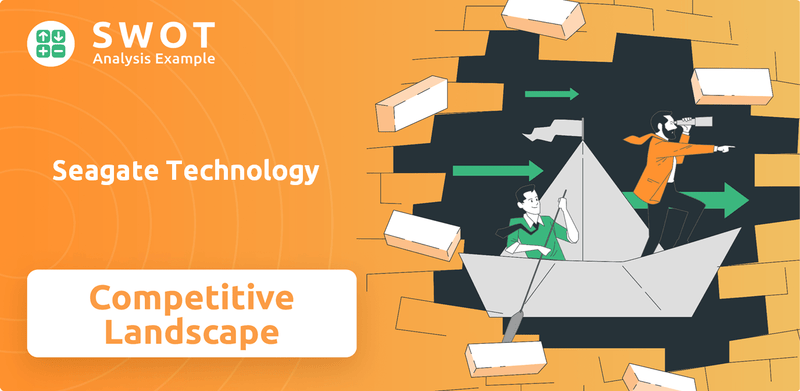
This comprehensive market analysis explores Seagate Technology's competitive advantages and the challenges it faces. We'll examine its competitors, market share, and strategic initiatives within the dynamic data storage industry. Furthermore, we'll analyze Seagate's financial performance, innovation, and strategies to compete effectively, providing insights for investors and business strategists alike.
Where Does Seagate Technology’ Stand in the Current Market?
Seagate Technology is a major player in the data storage industry, particularly known for its hard disk drives (HDDs). The company's core operations revolve around designing, manufacturing, and selling data storage solutions. These solutions cater to a wide range of applications, from enterprise data centers to consumer electronics.
The value proposition of Seagate lies in providing reliable, high-capacity, and cost-effective storage solutions. This is crucial for businesses and individuals needing to store and manage vast amounts of data. Seagate’s offerings include HDDs, solid-state drives (SSDs), and storage systems, serving diverse customer needs across various market segments.
Seagate holds a significant position in the data storage industry. As of Q4 2023, it controlled approximately 43.6% of the total HDD market share. This places it as one of the top two players, alongside Western Digital. Seagate is a leader in high-capacity Nearline HDDs, essential for cloud data centers and enterprise storage.
Seagate's product lines include HDDs for enterprise, desktop, notebook, and consumer electronics, as well as SSDs and storage systems. The company serves a diverse customer base. This includes hyperscale cloud providers, original equipment manufacturers (OEMs), small and medium-sized businesses, and individual consumers.
Seagate has a global presence, with significant sales and operations in North America, Asia-Pacific, and Europe. While HDDs remain a core strength, Seagate is expanding its SSD offerings, especially in the enterprise NVMe SSD space. This reflects a strategic shift to capture opportunities in both traditional and emerging storage markets.
The data storage industry is dynamic, with increasing demand for higher capacity and performance. Seagate faces competition from Western Digital and other SSD manufacturers. The company's ability to innovate and adapt to these trends is crucial for maintaining its market position. For more insights into the company's growth strategy, consider reading about the Growth Strategy of Seagate Technology.
Seagate's strengths include its strong market share in HDDs, a diverse product portfolio, and a global presence. Challenges involve adapting to the shift towards SSDs and managing competition in the data storage industry. The company must continue to innovate and invest in new technologies to maintain its competitive edge.
- Seagate's competitive advantages include its established brand and strong customer relationships.
- The company's financial performance is closely tied to the overall health of the data storage market.
- Seagate's strategies focus on mass capacity storage and expanding its SSD offerings.
- The company faces competition from both HDD and SSD manufacturers.
Seagate Technology SWOT Analysis
- Complete SWOT Breakdown
- Fully Customizable
- Editable in Excel & Word
- Professional Formatting
- Investor-Ready Format
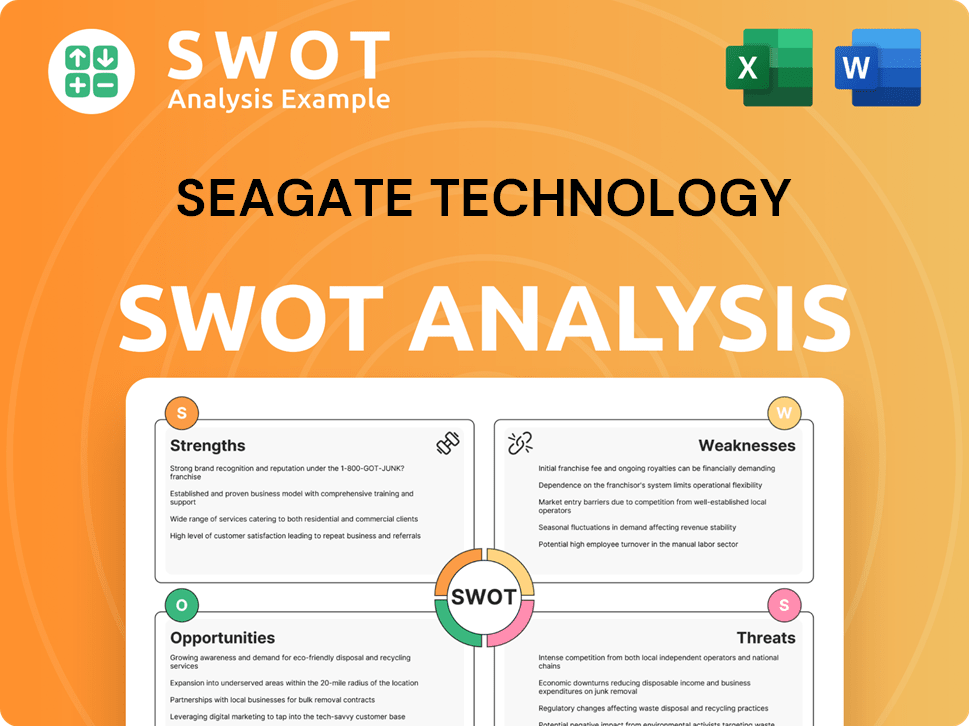
Who Are the Main Competitors Challenging Seagate Technology?
The competitive landscape for Seagate Technology is dynamic, with various players vying for market share in the data storage industry. A thorough market analysis reveals a complex interplay of direct and indirect competitors. Understanding these rivals is crucial for assessing Seagate's market position and future growth prospects.
Seagate's competitive advantages and challenges are shaped by the strategies and performance of its key competitors. The company faces pressure to innovate and adapt to evolving market trends to maintain its relevance. This includes navigating the shift towards cloud storage and the increasing demand for SSDs.
The data storage industry is marked by rapid technological advancements. These advancements require Seagate to continuously invest in research and development. This ensures it can offer competitive products and services.
Seagate's primary direct competitor is Western Digital. They compete head-to-head in the HDD market. Both companies are constantly innovating and releasing higher-capacity drives.
Western Digital is a major rival in the HDD market, competing intensely in both enterprise and client segments. They often engage in price wars and compete for large OEM contracts. Both companies are developing high-capacity HDDs for data centers.
Samsung is a significant competitor, especially in the SSD market, due to its vertical integration. Samsung's cost advantages and wide range of SSDs pose a challenge to Seagate. Micron Technology and Kioxia are also strong competitors in NAND flash and SSDs.
Cloud service providers like AWS, Microsoft Azure, and Google Cloud offer storage solutions, indirectly competing with Seagate. These services can reduce the demand for hardware. Emerging storage technologies also pose a challenge.
Seagate faces intense competition in both the HDD and SSD markets. This requires continuous innovation and strategic adjustments. The company must stay competitive in pricing and product offerings.
The data storage industry is constantly evolving, with new technologies and market trends. This requires Seagate to adapt its strategies to remain competitive. Understanding market dynamics is crucial for long-term success.
The competitive landscape is dominated by a few key players. These companies compete for market share in various segments. The HDD market remains crucial for Seagate, but the SSD market is growing rapidly.
- Western Digital: A major rival in the HDD market, with a significant market share. In 2024, Western Digital's revenue reached approximately $12.4 billion.
- Samsung: A dominant player in the SSD market, leveraging its NAND flash manufacturing. Samsung's SSD market share is substantial, with revenues exceeding $70 billion in 2024.
- Micron Technology: A strong competitor in the NAND flash and SSD markets. Micron's revenue in 2024 was around $23.2 billion.
- Kioxia: Formerly Toshiba Memory, Kioxia is another key player in the NAND flash market. Kioxia's market share and financial performance are significant, contributing to the overall competitive dynamics.
- Cloud Service Providers: AWS, Microsoft Azure, and Google Cloud offer storage solutions, impacting the demand for hardware. These companies have a considerable influence on the data storage market.
Seagate Technology PESTLE Analysis
- Covers All 6 PESTLE Categories
- No Research Needed – Save Hours of Work
- Built by Experts, Trusted by Consultants
- Instant Download, Ready to Use
- 100% Editable, Fully Customizable
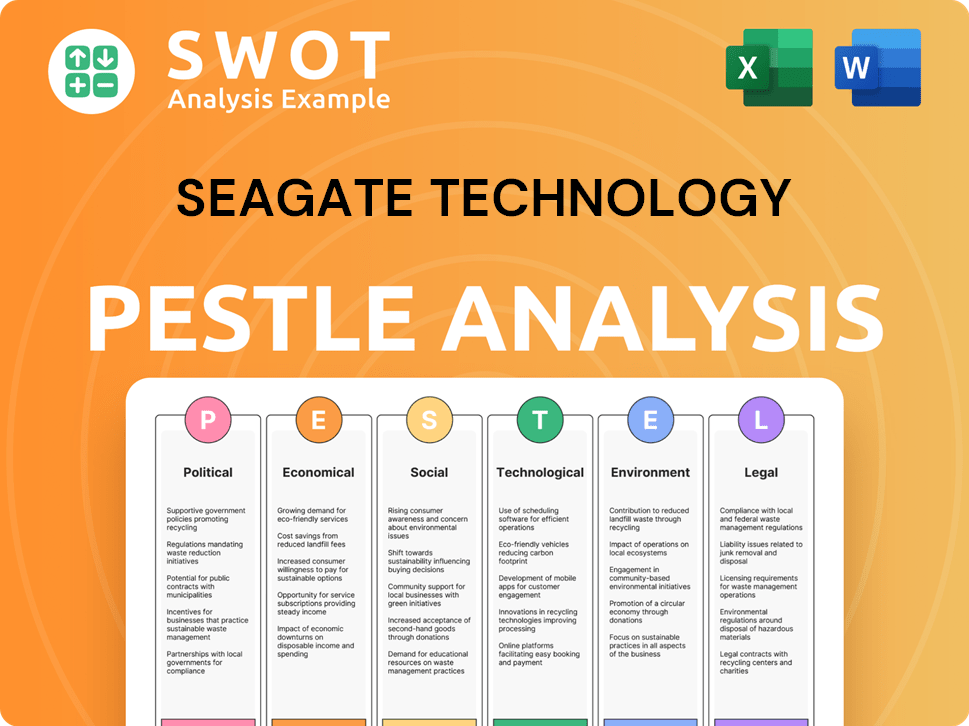
What Gives Seagate Technology a Competitive Edge Over Its Rivals?
The competitive landscape for Seagate Technology is shaped by its deep expertise in hard disk drive (HDD) technology, a substantial intellectual property portfolio, and strong relationships within the enterprise and cloud segments. A key differentiator for Seagate is its leadership in high-capacity Nearline HDDs, which are critical for the exabyte-scale growth of data centers. The company's focus on innovation, particularly in areal density, allows it to deliver higher capacities, as demonstrated by its early 2024 shipments of 30TB HAMR HDDs.
Seagate benefits from significant economies of scale in manufacturing and a well-established global distribution network, enabling efficient drive production and delivery to a diverse customer base. Its strong brand equity and reputation for reliability have fostered long-standing customer loyalty, especially among hyperscale cloud providers and large enterprises. The company's substantial patent portfolio in magnetic recording, heads, and media technologies provides a significant barrier to entry and safeguards its innovations. For a deeper understanding, you can explore the Brief History of Seagate Technology.
While the shift towards solid-state drives (SSDs) presents challenges, Seagate's continued investment in advanced HDD technologies like HAMR aims to sustain its competitive advantages in the mass capacity storage market. This strategic focus is essential for maintaining its market position and driving future growth. The company continually innovates to meet the evolving demands of data centers and cloud providers, ensuring its relevance in the data storage industry.
Seagate's key milestones include pioneering PC hard drives and transitioning to mass capacity enterprise storage solutions. The company has consistently pushed the boundaries of areal density, with the 2024 shipment of 30TB HAMR HDDs being a significant achievement. These milestones highlight its commitment to innovation and its ability to adapt to market changes.
Strategic moves include focusing on high-capacity Nearline HDDs and investing in technologies like HAMR. Seagate also emphasizes strategic partnerships with cloud providers and data centers. These moves aim to meet the growing demand for data storage and maintain a competitive edge in the HDD market.
Seagate's competitive edge stems from its technological leadership in HDDs, particularly in high-capacity drives. It benefits from economies of scale, a strong brand reputation, and a robust patent portfolio. These advantages enable Seagate to maintain a strong position in the data storage industry.
Market analysis indicates a growing demand for data storage, especially in cloud environments. Seagate's focus on high-capacity HDDs positions it well to capitalize on this trend. The company's ability to innovate and adapt to market changes is crucial for its continued success in the competitive landscape.
Seagate's competitive advantages include technological leadership in HDDs, economies of scale, a strong brand, and a robust patent portfolio. These factors contribute to its ability to maintain a significant market share in the HDD market. The company's focus on innovation, particularly in HAMR technology, is crucial for its long-term success.
- Technological Leadership: Focus on high-capacity HDDs and HAMR technology.
- Economies of Scale: Efficient manufacturing and global distribution.
- Strong Brand Reputation: Reliability and customer loyalty, especially with hyperscale cloud providers.
- Patent Portfolio: Significant barrier to entry for competitors.
Seagate Technology Business Model Canvas
- Complete 9-Block Business Model Canvas
- Effortlessly Communicate Your Business Strategy
- Investor-Ready BMC Format
- 100% Editable and Customizable
- Clear and Structured Layout
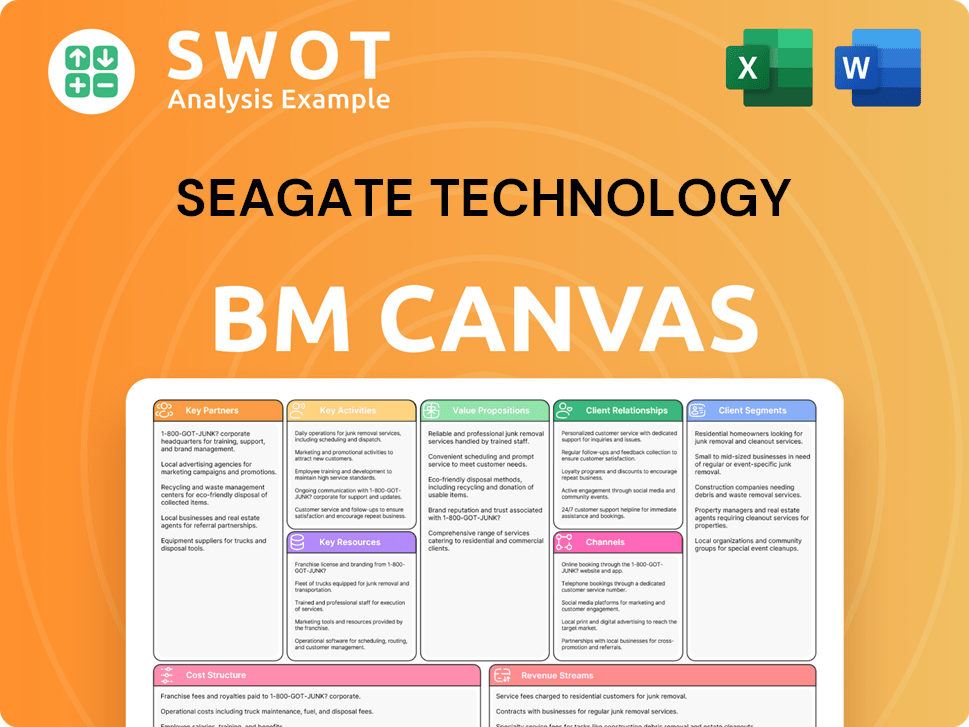
What Industry Trends Are Reshaping Seagate Technology’s Competitive Landscape?
The data storage industry is experiencing significant shifts, creating both challenges and opportunities for companies like Seagate Technology. The demand for data storage is exploding, driven by advancements in artificial intelligence (AI), machine learning (ML), and the Internet of Things (IoT). This surge in data generation favors Seagate's core strengths in high-capacity hard disk drives (HDDs), particularly Nearline drives designed for data centers. The expansion of cloud computing and edge computing further fuels this demand, providing avenues for Seagate's enterprise storage solutions.
However, the increasing adoption of solid-state drives (SSDs) for performance-sensitive applications presents a competitive hurdle. SSDs offer faster speeds and lower latency than HDDs, making them attractive for various uses. While Seagate has its own SSD offerings, it faces intense competition from established NAND flash manufacturers. Additionally, the cyclical nature of the storage market and potential oversupply can lead to price erosion, impacting profitability. Regulatory changes and data localization requirements could also influence market dynamics and supply chain complexities, adding to the challenges.
The data storage industry is witnessing exponential data growth, fueled by AI, ML, and IoT. Cloud computing and edge computing are expanding, increasing the need for storage solutions. The adoption of SSDs for performance-critical applications is rising, posing a challenge to HDDs.
The rise of SSDs presents a competitive challenge to Seagate's HDD business. Market cyclicality and oversupply can lead to price erosion. Regulatory changes and data localization requirements may impact market dynamics and supply chains. The competitive landscape is always evolving.
Seagate can capitalize on the growing need for storage in surveillance, industrial IoT, and automotive sectors. Innovation in HAMR technology and next-generation storage architectures can maintain its competitive edge. Strategic partnerships and collaborations can unlock new revenue streams. Read more about the Target Market of Seagate Technology to understand the opportunities.
The HDD market is still significant, with Seagate holding a substantial market share. The data storage industry is expected to continue growing, driven by the increasing volume of data generated globally. Seagate Technology needs to balance its HDD leadership with strategic expansion into SSDs and intelligent storage solutions.
Seagate must navigate the evolving competitive landscape by balancing its strengths in HDDs with strategic moves in SSDs and emerging storage technologies. Key strategies include innovation in HAMR technology to increase HDD capacity and performance, and strategic partnerships to expand its market reach.
- Focus on high-capacity HDDs for data centers and cloud storage.
- Expand SSD offerings to capture a share of the performance-driven market.
- Invest in next-generation storage architectures and technologies.
- Form strategic alliances with cloud providers and data management companies.
Seagate Technology Porter's Five Forces Analysis
- Covers All 5 Competitive Forces in Detail
- Structured for Consultants, Students, and Founders
- 100% Editable in Microsoft Word & Excel
- Instant Digital Download – Use Immediately
- Compatible with Mac & PC – Fully Unlocked
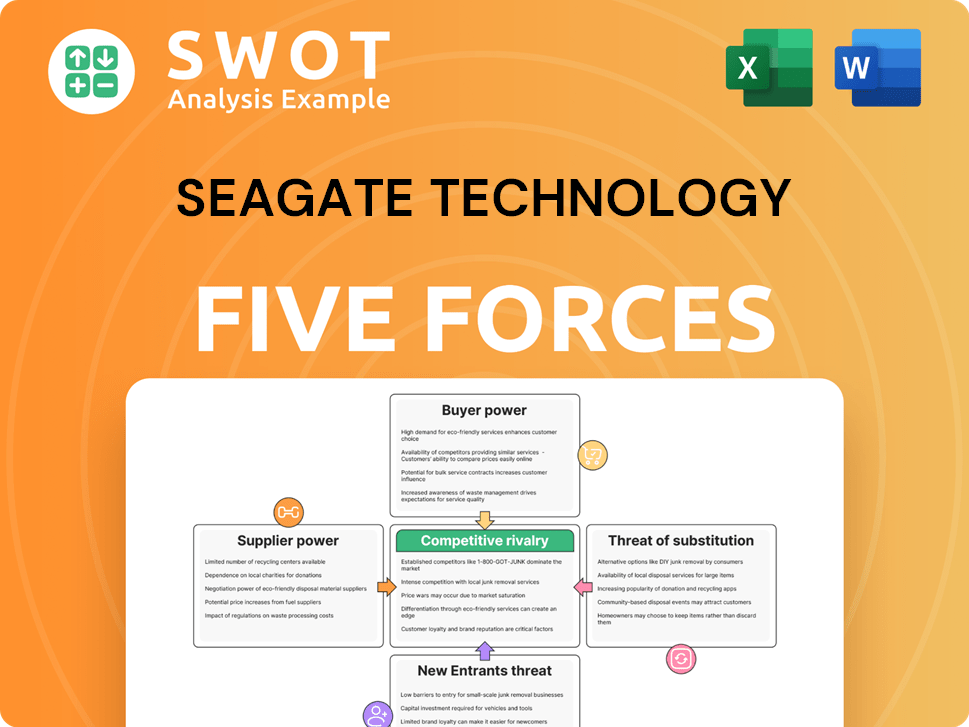
Related Blogs
- What are Mission Vision & Core Values of Seagate Technology Company?
- What is Growth Strategy and Future Prospects of Seagate Technology Company?
- How Does Seagate Technology Company Work?
- What is Sales and Marketing Strategy of Seagate Technology Company?
- What is Brief History of Seagate Technology Company?
- Who Owns Seagate Technology Company?
- What is Customer Demographics and Target Market of Seagate Technology Company?
Disclaimer
All information, articles, and product details provided on this website are for general informational and educational purposes only. We do not claim any ownership over, nor do we intend to infringe upon, any trademarks, copyrights, logos, brand names, or other intellectual property mentioned or depicted on this site. Such intellectual property remains the property of its respective owners, and any references here are made solely for identification or informational purposes, without implying any affiliation, endorsement, or partnership.
We make no representations or warranties, express or implied, regarding the accuracy, completeness, or suitability of any content or products presented. Nothing on this website should be construed as legal, tax, investment, financial, medical, or other professional advice. In addition, no part of this site—including articles or product references—constitutes a solicitation, recommendation, endorsement, advertisement, or offer to buy or sell any securities, franchises, or other financial instruments, particularly in jurisdictions where such activity would be unlawful.
All content is of a general nature and may not address the specific circumstances of any individual or entity. It is not a substitute for professional advice or services. Any actions you take based on the information provided here are strictly at your own risk. You accept full responsibility for any decisions or outcomes arising from your use of this website and agree to release us from any liability in connection with your use of, or reliance upon, the content or products found herein.